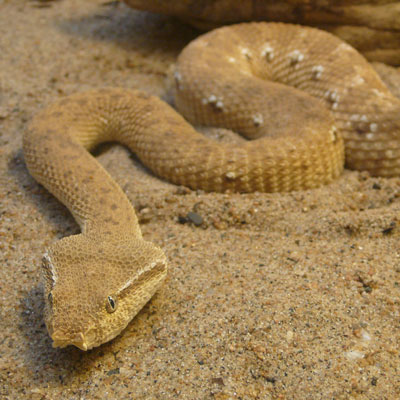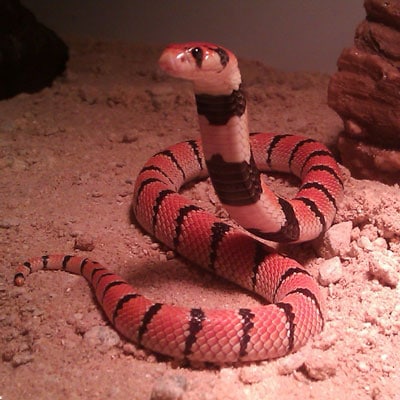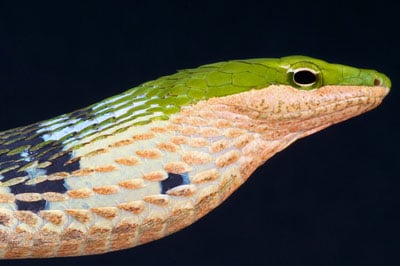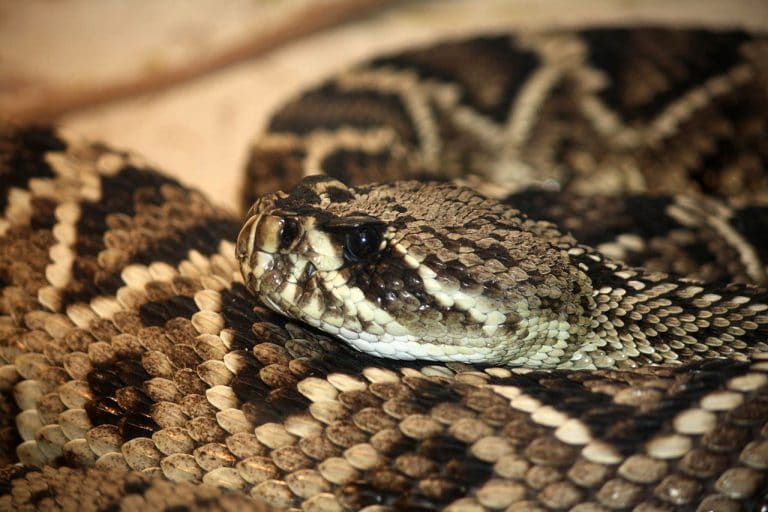Poisonous Snakes
Venomous or poisonous snakes are Serpentes suborder species that are capable of producing venom. The prominent venomous snakes are members of the Atractaspididae, Viperidae, Elapidae, and Colubridae families.
You can describe venomous snakes as reptiles that are capable of producing toxins in specialized glands, and possess a particular system of delivering the venom, injected using fangs when they bite their prey.
Most of the venomous snakes of the world have uncomplicated venoms that are easy to counter effectively with the right anti-venoms. Mamba bites, for example, you can treat easily, Other venomous species can create a host of medical problems for which anti-venoms are not available or not effective. Some rattlesnake bites have this effect.
Description
Venomous or poisonous snakes make use of modified saliva and snake poison, delivered through fangs that are, in fact, very specialized teeth, used to inject and immobilize the prey or for purposes of self- defense. Nonvenomous snake species, on the other hand, either constrict the prey or overcome it with their strong jaws.
Venomous snakes, as a whole, consist of several snake families and are not one taxonomic group. This can be taken to mean that venom in snakes must have originated many times because of convergent evolution. Recent evidence supports Toxicofera hypothesis which suggests that venom was there (albeit in small quantities) in all snake ancestors (some lizard species also) in the form of toxic saliva. In what is now termed Venomous by parallel Evolution, the toxic saliva evolved to extremes as venom. The hypothesis implies further that the non poisonous races might have the ability to produce poison, but still may carry venom pseudogenes or it is likely that they will still produce venom in insignificant quantities, sufficient to immobilize small prey but not capable of causing harm to humans.
Most Venomous Snakes
A lot of studies have been conducted on snake venom. The potency estimates show some variation. When you consider the toxicity of the venom of a species on the basis of L D on mice alone, it will not reflect the danger the venom may cause to humans. Another problem that we face in classifying the most poisonous snakes, is the physiological differences between the humans and the animals tested. The common indicators used to test venom of poisonous snakes in LD50 tests are mice. The LD tests cannot convey the actual effects of the venom on humans, because of the physiological differences that exist between humans and Mice. Moreover, most poisonous snakes are specialists in the predation of mice. It is possible that these snakes adapt their venom to immobilize mice Many mammals do have rather similar physiologies However, LD50 results may not have direct relevance to humans.
The Inland Taipan Snake venom, per/ drop, is the world’s most toxic snake venom. If we base our findings on average lethal dose on mice. It is definitely higher than even that of sea-snake venom. Even when tested on human heart culture, it is decidedly the most venomous.
Despite having the dubious distinction of being the world’s most venomous snake, according to LD50 tests, the Taipan (inland) has not killed any human beings.
To calculate the danger to human beings, the toxicity of the venom of the snake is used as the indicator. There is a host of factors that are decidedly more critical when we try to determine the potential danger that a particular venomous snake poses to human beings. Factors like distribution and the behavior of the snake species, etc. are more important.
Most Deadly vs. Most Dangerous
When we discuss venomous snakes, it is necessary to remember that the ‘deadliest’ snakes are not the’ most dangerous’ ones. These are two totally different concepts.
Some of the most lethal snakes (the ones with the most toxic venom), seldom bite people. The ‘deadly Seasnakes’ are usually very docile. The inland Taipan snakes, reputedly the ones with the most lethal venom, have not killed any human beings. Interestingly, the snakes that kill the maximum number of people, are the ones with ‘milder venom’ when compared to the other poisonous snakes.
Ten Most Venomous Snakes
Rattlesnake

The only venomous snake from America to make the list is the Rattle Snake. It is easy to identify the rattlesnake by the rattle on its tail. Rattlesnakes belong to the family of pit vipers. It can strike up to two thirds of its body length. Eastern Diamondbacks are the most venomous species in Noth America. Incredibly, they say that the juvenile snakes of the species are said more dangerous than the adults, They do not have the ability to control the quantity of venom they inject. Rattlesnake venom is hemotoxic. The venom destroys tissues, degenerates organs and cause coagulopathy or clotting or bleeding disorder. Permanent scarring up to a degree is possible in the case of a venomous bite even if the patient has received immediate and effective treatment. This can lead to the loss of limbs or even death. The common symptoms of rattlesnake bite are; paralysis, drooling, difficulty in breathing and massive hemorrhage. Potentially, rattlesnake bites are fatal. Untreated rattlesnake bites are more often than not, fatal. If antivenin is applied immediately, the death rate is less than four percent.
Death Adder

Death adder is an apt term for these snakes that we can see in New Guinea and Australia. Death Adders really hunt and kill other snakes. They ambush and kill their victims. These snakes resemble vipers due to the triangle shaped heads and short, stout bodies. Typically, they inject about 40-100 milligrams of their venom with an LD (Lethal Dose) of 0.4 to 0.5 mg per kg. An untreated Death Adder-bite is quite dangerous and fatal. The venom of the Death Adder, is a neurotoxin. The adder bite can cause paralysis as well as death in six hours. Antivenin is highly effective in the treatment of Death Adder bites. This is due to the very slow progression of the symptoms. Before the antivenin was developed, death adder bites’ fatality rate was 50%. The Death Adder has the quickest strike. A Death adder can strike from its striking position and revert back to the striking position in just 0.13 seconds.
Vipers

You can find vipers almost throughout the world. Saw Scaled Vipers and Chain Vipers are definitely most venomous. You can locate them mainly in the Middle East, Central Asia, especially in India and China as well as South Eastern parts of Asia. Vipers are usually nocturnal and are very quick-tempered. They are generally very active after it rains. They are very quick. The venom of the species cause symptoms that start with pain at the bite site. Swelling of the affected part follows. Bleeding, especially from the gums, is common. The blood pressure drops and the Heart rate will fall. Blistering happens at the bite site and along the affected limbs. You will find superficial Necrosis confined to the muscles near the bite. This can become severe. About 1/3 of all cases report facial swelling and vomiting. Extreme pain will last for two to four weeks. The swelling at the site peaks in 2-4 days. Discoloration starts in the swollen area. Death due to septicaemia, cardiac or respiratory failure can occur within 1-14 days or more, after the bite.
Philippine Cobra

Most Cobra species ordinarily will not find a place in this list. Philippine Cobra is the sole exception. This snake has the most lethal venom of all cobra species. Moreover, they can spit the venom up to a distance of three meters. The venom of the Philippine Cobra is a neurotoxin. This affects cardiac as well as respiratory systems. The venom can also induce neurotoxicity, paralysis of the respiratory system and death within half an hour. Tissue damage from the bite is minimal. The neurotoxins affect the victims by interrupting the transmission of nerve signals. This they do with binding the neuromuscular junctions at the side of the muscles. The symptoms are Nausea, headache, vomiting, dizziness, diarrhea, abdominal pain, convulsions and collapse.
Tiger Snake

We can find Tiger Snakes in Australia. These species have very lethal neurotoxic poison. Death from the bite of this snake can happen in 30 minutes. Usually this takes between 1 to 24 hours. Before they developed the anti-venom, the fatality rate of this species was 60 to 70%. Symptoms include pain in the foot and neck regions (localized), tingling sensation, numbness as well as sweating. There is the rather quick onset of breathing difficulties, followed by paralysis. When encountered, tiger snakes usually try to flee. They become aggressive when cornered. They can strike with uncanny accuracy.
Black Mamba

We can find the dreaded Black mamba in many parts of the African Continent. These snakes are very aggressive. They strike with lethal precision. They are the world’s fastest land snakes. They can reach speeds of up to 20 kilometers an hour. They can strike up to 12 times in one stretch. The venom of a single snake bite is sufficient to kill 10 to 25 adults. The snake’s venom is a kind of quick-acting neurotoxin. It can, on an average, deliver around 100 to 120 milligrams of venom per bite. It is, however, capable of delivering up to 400 mgs. Remember, if the venom finds a vein, 0.25 mg/kg is enough to kill a human in fifty percent of the cases. The initial symptoms are: localized pain in the area of the bite, a tingling sensation around the mouth, extremities, tunnel vision, double vision and utmost confusion and paralysis. Uncontrolled salivation which includes foaming, lack of muscle control (Ataxia), nausea, vomiting, shock, pallor, cardio and nephrotoxicity as well as paralysis. Convulsions, pulmonary arrest, Coma and death follows. In the absence of antivenin, the death rate is almost 100%. These are the highest post bite symptoms among all poisonous snakes. According to the nature of the bite, death can occur any time from fifteen minutes to three hours.
Taipan

The Taipan is another lethal snake from Australia. They claim that the venom is potent enough 12,000 guinea pigs. The venom causes severe clotting of the blood, blocking veins and arteries. The venom is also very neurotoxic. Before antivenin was developed, nobody survived a Tapan bite and death usually occurred within an hour of the bite. Even when antivenin is successfully administered, it is likely that the victim will have an extended stay in intensive care. The Taipan is comparable to the black Mamba in terms of ecology, morphology and behavior.
Blue Krait

The Blue Krait is the deadliest of the species. We can see these snakes throughout Indonesia and southeast Asia. 50% of the Blue Krait bites are mortal, even with antivenin administration. The Kraits hunt other snakes and kill them. They also love a little cannibalism on the side, killing and eating other Kraits. They are nocturnal and very aggressive in the dark of the night. They really are timid and would rather hide than fight. The Krait venom is neurotoxic, 10 to 16 times more potent than Cobra venom. The venom induces muscular paralysis in the victim. It does so by inhibiting the chemicals that facilitate the transmission of messages at nerve endings. This is followed by cramps, spasms and tremors caused by over excitation. Paralysis follows. Bites from Kraits are comparatively rare owing to their nocturnal nature. Before the antivenin was developed, the death rate was about 85%. Even with the administration of antivenin, You have no assurance of survival. Death occurs within 6 to 12 hours after the Krait’s bite. If there is inordinate delay in giving medical care, permanent coma and brain death may result.
Eastern Brown Snake

The name is innocuous, is it not? It will surprise you to know that 1/14000 of an ounce of this snake’s venom can kill a human adult. The Brown Snake is certainly the most venomous in the species. Their habitats are among the densely populated areas of Australia. The snake moves fast and aggressively in some circumstances. They even chase aggressors and strike at them repeatedly. Juveniles even can kill humans. Fortunately for humankind, less than 50%mof their bites contain venom and they would rather not bite. These snakes react only to movement. Standing still is the best option if you ever encounter one.
Fierce Snake or Inland Taipan

The inland Taipan has the unique distinction of being the possessor of the most toxic venom among the land snakes in the world. One bite can yield 110 milligrams of venom which is potent enough to kill one hundred humans or 250,000 mice. It has an LD50 of 0.03 mg/kg. It is ten times more poisonous the Rattlesnake of Mojave and 50 times more venomous than the common cobra. Fortunately for humans, the Inland Taipan is not a very aggressive snake and you rarely encounter it. Even though it could potentially kill a human in just 45 minutes, there has been no reports of human casualties.
Belchers Sea Snake

This is the world’s most venomous snake. A few milligrams of its venom could kill a thousand people. Fortunately, less than 25% of their bites contain venom and these snakes are very docile by nature. The usual victims are fishermen who encounter these snakes when they attempt to pull nets from the ocean. We can find these snakes all through the waters of northern Australia and the middle east.
Lesser-Known Highly Venomous Snakes
You can read about some of the lesser known venomous snakes below:
Mexican Jumping Viper

These pit vipers, found in the Mexican and the Central American rain forests, resemble the Puff-Adder and the Gaboon Viper of Africa with their flattened heads and their large, thick and short bodies. They lift their bodies from the ground to attack with sheer force. However, they attack only if provoked.
Mamushi

The Mamushi, found in Japan, Korea and China belong to the family of Pit Vipers. Most Japanese consider this snake as the most dangerous in the country and find similarities with the American Copper Head and the Rattlessnake. Its venom is very potent, causing hemorrhages. It can grow up to about 3 feet long, feeds on small mammals and frogs and fish and is viviparous.
Water Cobra

These snakes, by virtue of the fat that they can form a hood by flattening its ribs, is confused with a Cobra even though their genus is different. They are aquatic and remain in the water for a long time. They can grow to about 8 feet in length. They will bite only if you harass them even though they are very venomous.
Spiny Tree Viper

Its keeled scales offer it a bristly or spiny appearance. The snake is very venomous and you have no known and antidote for its venom. If you come across one, treat it with the respect it deserves.
Coral Cobra – Aspidelaps (Elapid Family)

Though these snakes do not belong to the true Cobra species, their ability to flatten their head into a hood brings in a resemblance to cobras. They have poor eyesight and short fangs that deliver a very venomous bite. Avoid them as much as possible because you cannot find an anti-venom for their bites.
Burrowing Asp

This burrowing species of asps, found in Africa have their fangs protruding out of their mouths, enabling them to strike its prey without even opening its mouth. They are not very venomous but can hurt children with their bite.
Hog Nosed Pit Viper

The Hognosed Pit Vipers, inhabitants of Mexico, South and Central America, are a small snake that injects the deadly hemotoxic venom that destroys the vessels and blood cells. You can find them in the rain forests and coastal areas.
Golden Lancehead

These snakes live exclusively in dense populations in the Queimada Grande Island in Brazil and feed on birds as there are no mammals on this Island. Their poison is quick reacting, potent and really strong. The Island is so heavily infested with these highly venomous snakes that the Brazilian Government has declared it a restricted region and most people consider it as the most risky spot in the world.
Twig Snake

Belonging to the Colubridae family, these slender snakes are venomous like the Boomslang, and have their venomous fangs located in the back part of the mouth, which renders them less deadly than the Pit Vipers or Cobras. Their venom, however, is deadly and highly toxic to human beings.

Having discovered a fondness for insects while pursuing her degree in Biology, Randi Jones was quite bugged to know that people usually dismissed these little creatures as “creepy-crawlies”.







